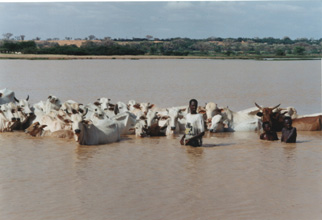Le rêve plus fort que la mort
Der Traum ist stärker als der Tod
La vache merveilleuse
Jean Rouch
Frankreich 2002 |
| |
|
 |
|
|
Delphi
15.02., 14.00
CinemaxX 3
16.02., 18.15
Babylon
17.02., 14.00
Arsenal 1
17.02., 17.30
|
|
|
|
|
Produktion: AMIP - IRD - CNRS Images/me-dia
sowie Centre National de la Cinématographie
Kontakt: AMIP, 52 rue Charlot, 75003 Paris
Tel.: (33-1) 48 87 45 13, Fax: 48 87 40 10
email: amip@amip-multimedia.fr
Buch: Jean Rouch, zusammen mit Bernard Surugue
Kamera: Gérard de Battista, Djingarey Maïga
Ton: François Didiot, Moussa Haidou
Schnitt: Françoise Beloux
Format: 16mm, Farbe
Länge: 70 Minuten, 24 Bilder/Sek.
Sprachen: französisch, altgriechisch, peul,
fulfulde, tamachek, songhai |
|
|
|
|
Jean Rouch erzählt uns drei Träume von Freundschaften und dionysischen
Abenteuern. Erster Traum: Damouré, der Rouch einst
in die Rituale des Flusses Niger eingeführt hat, kehrt nach
Hause zurück, nachdem er in Ghana reich geworden ist und eine
große Familie gegründet hat. In seinem schwarzen Jaguar
mit offenem Verdeck fährt er durch ein verändertes Niamey. Bald
wird Damouré klar, dass die Dinge nicht mehr sind, wie sie einmal
waren. Und dem muss er entgegentreten und Opfer bringen
nach den Vorschriften der Rituale.
Zweiter Traum: Als Rouch mit seinen Freunden den Fluss Niger
hinab fuhr, konnte er Damouré nicht mitnehmen. So trat Lam
Ibrahim Dia an dessen Stelle, der Hirte vom Stamm der Peul, ein
junger Mann von irgendwoher. Im Verlauf der Fahrt erzählte er
von seiner Marabout-Reise nach Nigeria, wo er wunderkräftige
weiße Kühe entdeckt hatte. Sie sprachen sogar Hindi, aber die
Einwohner trauten ihnen nicht, weil sie keine Hörner hatten.
Dritter Traum: In einem antiken Theater findet die seltsame
Aufführung eines Stückes von Aischylos statt, multikulturelle
Schauspieler spielen ‘Die Perser’. ‘Barbaren’ sprechen
und tanzen
in adaptiertem Altgriechisch und in moderner Peul-Sprache.
Aus Bequemlichkeit haben die Komplizen-Dichter die Dialoge in
die Sprache der Kolonisatoren übersetzt. Im Schatten agieren
ganz nah und auf der Suche nach Licht die antiken Doppelgänger
der Schauspieler mit einem Abstand von 25 Jahrhunderten.
|
| |
|
|
Jean Rouch recounts three dreams of
friendship and Dionysian adventures. First
dream: Damouré, the man who introduced
Rouch to the rituals of the River Niger, returns
home after making his fortune in
Ghana and fathering a large family. He
drives through present-day Niamey in his
black, open-top Jaguar looking at the department
stores, a bridge, the paved roads.
The city is ten times the size it was.
Damouré soon realises that things are not
what they once were. So in order to rectify
this, he decides to make a ritual sacrifice.
Second dream: Rouch and his friends take
a trip down the River Niger, but they can’t
take Damouré along because he doesn’t
have permission to leave the country. So
Damouré’s place is taken by Lam Ibrahim
Dia, a young Peul cowherd from somewhere
or other. During the trip, he tells of his
marabout journey to Nigeria, where he discovered
marvellous white cows that were
very soft and came from India. They even
spoke Hindi, but the locals didn’t trust
them because they didn’t have horns. Nor
could they drink their milk. They were indeed
the Devil’s own cows.
Third dream: in an ancient theatre, a multicultural
group of actors gives a strange
performance of Aeschylus’ ‘The Persians.’
“Barbarians“ dance and speak in adapted
ancient Greek and the modern Peul language.
For the sake of convenience, the accomplice
poets have translated the dialogues
into the language of their
colonisers. Close by, in the shadows, the
actors’ ancient doubles from 25 centuries
earlier seek out the light.
|
| |
|
Biographien / Biographies
Jean Rouch, geb. 1917 in Paris. Filme seit 1947, Pionier des ethnografischen
Films, bis heute über 150 Dokumentar- und Spielfilme. Im Forum u.a.
Enigma (1988), Egalité, fraternité et li-berté... et
puis après (1990), Madame l’eau (1993), Moi fatigué debout,
moi couché (1997). |
